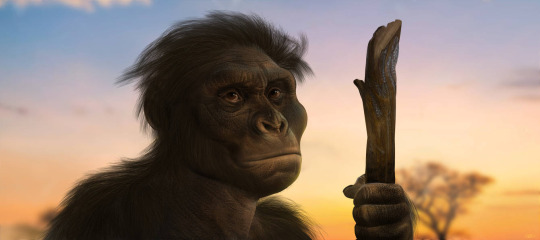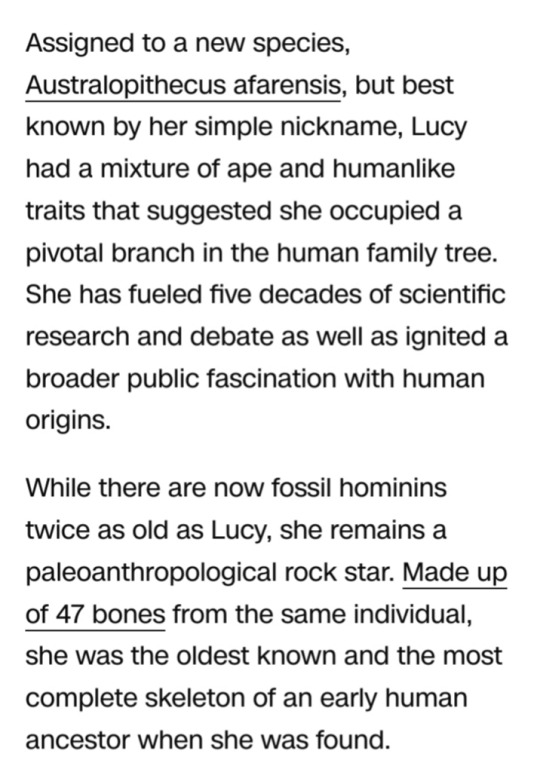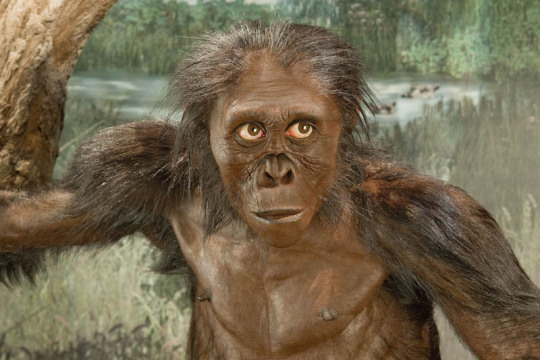#Australopithecus afarensis
Explore tagged Tumblr posts
Text
Love Kennis & Kennis reconstructions of ancient humans. Love the life they give them.










australopithecus afarensis "Lucy", australopithecus sediba, homo erectus pithecantropus, homo ergaster "Turkana boy", homo floresiensis, homo neanderthalensis x2, early homo sapiens from Jebel Irhoud, "Ötzi the Iceman" and neolithic woman Lisar.
#facial reconstructions#kennis & kennis#ancient humans#lucy#australopithecus afarensis#australopithecus sediba#homo erectus#homo ergaster#homo floresiensis#homo neanderthalensis#homo sapiens
70 notes
·
View notes
Text

Lucy (Australopithecus afarensis)
Habitat & Distribution
Resided in both dense woodlands and grasslands
Found primarily in east Africa
The species lived between 3.7 and 3 million years ago
Physical Description
Weight: Likely about 44.6 kg (98 lb) for males and 29.3 kg (65 lb) for females
Height: Likely about 151 cm (4 ft 11 in) for males and 105 cm (3 ft 5 in) for females
Both sexes were likely covered in fine, dark hair and had stout bodies; like many simian primates, they had long arms and a thick, domed head
Behaviour
A. afarensis was likely an omnivore, consuming grasses, leaves, fruits, and roots; they may have also eaten meat, likely that of smaller mammals and fowl
Likely predators included hyenas, lions, and leopards
Like other primates, A. afarensis was highly social, and likely lived in family groups or in a hierarchy of females dominated by a male
Key Advantages
A strong climber, and likely quite agile among the trees
May have used rudimentary stone tools
See where they stand in the May Mammal Madness Tournament here!
Photo by John Gurche
49 notes
·
View notes
Text

#Moon-Watcher#Moonwatcher#Moon Watcher#2001 aso#2001 a space odyssey#space odyssey#a space odyssey#2001#aso#2001: A Space Odyssey#Stanley Kubrick#Arthur C. Clarke#Daniel Richter#Australopithecus afarensis#dawn of man#the dawn of man#hug kiss marry kill
4 notes
·
View notes
Text

†Australopithecus afarensis
Art credit: Kepyle2055
Over the last few million years, a huge variety of hominins (human relatives) have arisen, only to go extinct and leave us all alone. A. afarensis lived from about 3.9-2.9 million years ago, and were short bipedal apes which were good at walking and might have been able to climb. They appear to have been highly adaptable, occupying a variety of environments- forest, savanna, etc- in east Africa. They likely ate a variety of foods, including grass, leaves, seeds, fruits, roots, insects, and small vertebrates.
#markhors-menagerie#primates#apes#great apes#hominins#animal facts#fun facts#palaeontology#animals#biology#prehistoric life#prehistoric animals#australopithecus#australopithecus afarensis
34 notes
·
View notes
Note
A. Afarensis from the, past

7 notes
·
View notes
Text








xxx
CNN: How did the fossil get the name Lucy?
Johanson: Because of the delicate nature of the bones and the short stature, we felt she was probably a female.
(Subsequent fossil discoveries revealed that males were much bigger than females.)
That night in camp, we were playing the Beatles’ (album).
“Sgt. Pepper’s Lonely Hearts Club Band” and “Lucy in the Sky With Diamonds” were playing when one of the camp members said, “Why don’t you call her Lucy?”
It was just serendipity that it happened, but it stuck. It was, in many ways, an attractive name.
People could identify with it. It made those bones a person. It drew you in and made you want to know more.
And she’s been the touchstone (of human origins) for the average person.
CNN: What was Lucy’s significance at the time that she was discovered?
Johanson: She was the oldest, most complete hominin known at that time.
This was terra incognita in the early ‘70s. Very few people had been to this region of Ethiopia, and people began launching their own expeditions and finding even more exciting things in some ways.
But I think that Lucy was the spark. She ignited a new stage in human origins research.
What she did, most importantly, was she broke the 3 million-year time barrier.
The site of Hadar, which is a local name, is very fossil-rich.
And it turned out to produce an enormous number of fossils of her species and gave us a really important benchmark by which all other discoveries that were made in the Afar could be judged.
#Lucy#Don Johanson#ethiopia#National Museum of Ethiopia#human evolution#paleontology#ancient hominins#Australopithecus afarensis#early human ancestor#Institute of Human Origins#Neanderthal genes#Neanderthals#homo sapiens#Denisovans#hominin species#argon dating#Hadar#fossils#fossilized skeleton#Tom Gray#human origins
3 notes
·
View notes
Video
youtube
I’ve been thinking about ancient hominids a lot lately so have A Man
4 notes
·
View notes
Text
If you know me in real life, you probably know I save my nerdiest, most sincere love for anthropology-related things. Lucy is a really really sweet Australopithecus afarensis specimen found in Ethiopia in 1974. She has been dated to about 3.2 million years ago and helped us learn a whole lot about early hominins. . (The doodle is just a general A. afarensis, but I am calling her Lucy because I feel like it) -- Moi -- May 2019

2 notes
·
View notes
Photo
Apparently I am an 'Australopithecus afarensis!'


OK, I’m a Neanderthal, according to this quiz (created by a student at Appalachian State University)
The few. The Proud. The Neanderthals:


7K notes
·
View notes
Text
Researchers have unveiled the appearance of one of our earliest human ancestors @neosciencehub #HumanAncestors #Ethiopia #Lucy #Sciencenews #Wildlife #neosciencehub
0 notes
Text
glancing up, reaching down
my mother is angry at the traffic jam on the street- its a homeless man who got hit while trying to cross the road. The person who hit him had just glanced over him like he was already gone. Tonight, his candlelight vigil is comprised of blinking red tail lights and his gospel song a wailing siren. sometimes a person's whole life is worth fifteen minutes of delay and someone who will throw their hands up in exasperation and ask, “What is it this time?”
Yes, up is the direction we all tend to glance. Maybe someone looks skyward and sees god but I spent my whole life in city and I can’t see the heavens through all the smog. the only figures i know capable of causing world ending floods and life saving miracles are the ones who hold conference meetings at the top of the buildings i drive past on the way to school. After all, they offer the same promise: a splendid routine. Predictability, efficiency, calculability, control. “God” is at the top of a building reassuring you. Don’t worry, there is a place for you, preternaturally assigned based upon your actions, your worthiness. Oh, sorry, worth. A dead man in the road is just an obstacle on the stairway to heaven
The billionaires will chase comet tails but I know the divinity I'm looking for is in the ground. Two months ago I held Lucy’s plastic skull in my hands and stared her in her empty eyes and saw the cosmic dust that sparked the long line of coincidences and butterfly wing flaps that became our reality. Did you know that we left africa twice? The first time we failed and yet the second time we lived. history likes to tell a linear story (a winners story), like the hominins all got in lanes divided by broken white lines and coasted. In that tale, no one crosses the road when they aren’t supposed to and we proceed cleanly to our great modern society.
And yet Lucy left africa, even though she was never meant to and the best part is that she went home too. She went home but by sheer love and adoration, her head was in my hands, and the plastic was warm because someone else had held her just before. She wasn’t one of us but she is loved all the same.
My roommate whispers to me in the lecture hall, “I'm not supposed to be here,” and yet here you are! You ought to thank Lucy! She is winking at you- her other name has stretched its hand across the binding ties of time to place itself on your shoulder to give you her own promise: “you are marvelous!” the bones in the earth love you more than the buildings ever will
Maybe god is in the sky but everything we love we eventually put in the ground.
#anyways#:')#lucy#aka#australopithecus afarensis#which is dinkinesh in amharic#which means#you are marvelous
1 note
·
View note
Text



1 note
·
View note
Text

Experiment:
Reblog this post and add a poll of your own to the reblog. You can make it a poll about anything. Let's see how far it goes.
#would they be good at asmr#australopithecus#Australopithecus afarensis#early man#polls#poll#random polls#poll experiment#long post#nonsense polls#asmr#asmr sounds#autonomous sensory meridian response#asmrtist#fun polls#tumblr polls
5K notes
·
View notes
Text
Lucy: 50 anos do fóssil humano mais antigo
Lucy é mesmo fóssil humano mais antigo? Há quem duvide. Em 1974, uma descoberta na região de Hadar, na Etiópia, mudou a compreensão que temos sobre nossas origens. Foi datado de 3,18 milhões de anos atrás. Ao ser econtrado, abalou o mundo científico como um dos achados mais significativos. Os paleontólogos então acreditaram que o achado lançava luz sobre a evolução humana. A revista Science…

View On WordPress
1 note
·
View note
Text
Computer models advancing science
Computer modeling has become a more and more important tool for science. We have seen it in Climatology for decades, as well as in a number of other fields. People who have a poor understanding of science, or who are trying to deny science, such as creationists and climate change deniers, will often claim that it isn’t really real science, but that is of course pure nonsense, as empirical…
View On WordPress
#Australopithecus afarensis#Cambridge University#Dr Ashleigh Wiseman#Evolution#Lucy#Royal Society Open Science#ScienceDaily
1 note
·
View note
Text
Nueva reconstrucción muscular en 3D de 'Lucy', el Australopithecus afarensis, revela que caminaba erguida y flexionaba una fuerza impresionante. Esto podría revolucionar nuestra comprensión de la evolución del movimiento humano.
0 notes